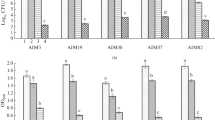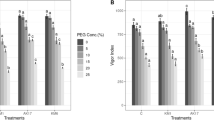Abstract
The water potential of rhizospheric soil is a key parameter that determines the availability of water, oxygen, and nutrients to plants and microbes. Recent global warming trends and erratic precipitation patterns have resulted in the emergence of drought as a major constraint of agricultural productivity. Though several strategies are being evaluated to address this issue, a novel approach is the utilization of microbes for alleviation of drought stress effects in crops. Citricoccus zhacaiensis B–4 is an osmotolerant actinobacterium isolated from banana rhizosphere on mannitol supplemented medium (−2.92 MPa osmotic potential). This isolate expressed plant growth promotion traits viz, IAA, GA3 production, phosphate, zinc solubilization, ACC deaminase activity and ammonia production under PEG induced osmotic stress and non-stress conditions. Under in vitro osmotic conditions, biopriming with the actinobacterium improved the percent germination, seedling vigour and germination rate of onion seeds (cv. Arka Kalyan) at osmotic potentials up to −0.8 MPa. Considering its novelty, osmotolerance and plant growth promoting traits, biopriming with C. zhacaiensis is suggested as a viable option for the promotion of onion seed germination under drought stressed environments.


Similar content being viewed by others
References
Altenburger P, Kämpfer P, Schumann P, Steiner R, Lubitz W, Busse HJ (2002) Citricoccus muralis gen. nov., sp. nov., a novel actinobacterium isolated from a medieval wall painting. Int J Syst Evol Microbiol 52:2095–2100
Armada E, Roldán A, Azcon R (2014) Differential activity of autochthonous bacteria in controlling drought stress in native lavandula and salvia plants species under drought conditions in natural arid soil. Microbiol Ecol 67:410–420
Barber SA (1995) Soil nutrient bioavailability: a mechanistic approach, 2nd edn. Wiley, New York
Basra AS, Singh B, Malik CP (1994a) Amelioration of the effects of ageing in onion seeds by osmotic priming and associated changes in oxidative metabolism. Biol Plant 36:365–371
Basra AS, Singh B, Malik CP (1994b) Priming-induced changes in polyamine levels in relation to vigor of aged onion seeds. Bot Bull Acad Sinica 35:19–23
Bennett AJ, Mead A, Whipps JM (2009) Performance of carrot and onion seed primed with beneficial microorganisms in glasshouse and field trials. Biol Control 51:417–426
Bennett AJ, Whipps JM (2008) Beneficial microorganism survival on seed, roots and in rhizosphere soil following application to seed during drum priming. Biol Control 44:349–361
Bhanuprakash K, Yogeesha HS, Naik LB, Arun MN (2006) Studies on physiological and biochemical changes in relation to seed viability in aged onion seeds. J Hortic Sci 1:15–18
Bhatt RM, Selvakumar G, Upreti KK, Boregowda PC (2014) Effect of biopriming with Enterobacter strains on seed germination and seedling growth of tomato (Solanum lycopersicum L.) under osmotic stress. Proc Natl Acad Sci India B B 10.1007/s40011-014-0333-8
Bradford KJ (1986) Manipulation of seed water relations via osmotic priming to improve germination under stress conditions. Hort Sci 21:1105–1112
Çağlar KH, Güvenç İ, Yarali F, Dönmez MF (2009) The effects of bio-priming with PGPR on germination of radish (Raphanus sativus L.) seeds under saline conditions. Turkish J Agric For 2:173–179
Daveman I (2006) Effects of seed priming with PEG or K3PO4 on germination and seedling growth of lettuce. Pak J Biol Sci 11:923–928
Devaraju PJ, Nagamani S, GowdaRV Yogeesha HS, Gowda R, Nagaraju KS, Shashidhara N (2011) Effect of chemo priming on plant growth and bulb yield in onion. Int J Agric Environ Biotechnol 4:121–123
Grover M, Ali Sk Z, Sandhya V, Rasul A, Venkateswarlu B (2011) Role of microorganisms in adaptation of agriculture crops to abiotic stress. World J Microbiol Biotechnol 27:1231–1240
Hadas A (1976) Water uptake and germination of leguminous seeds under changing external water potential in osmoticum solution. J Exp Bot 27:480–490
Halmer P (2000) Commercial seed treatment in seed technology and its biological basis. In: Black M, Bewley JD (eds) seed technology and its biological basis. Sheffield Academic Press, Sheffield, pp 257–286
Hosseini SZ, Jafari M (2002) Investigation on effect of salinity stress on germination of three accessions of tall wheat grass (Agropyron elongatum). 17th WCSS, Thailand, p. 2289
Jisha KC, Vijayakumari K, Puthur JT (2013) Seed priming for abiotic stress tolerance: an overview. Acta Physiol Plant 35:1381–1396
Kelen M, Demiralay EC, Sen S, Ozkan G (2004) Separation of abscisic acid, indole-3-acetic acid, gibberellic acid in 99 R (Vitis berlandieri x Vitis rupestris) and rose oil (Rosa damascena Mill.) by reversed phase liquid chromatography. Turk J Chem 38:603–610
Kim OS, Cho YJ, Lee K, Yoon SH, Kim M, Na H, Chun J (2012) Introducing EzTaxon-e: a prokaryotic 16S rRNA gene sequence database with phylotypes that represent uncultured species. Int J Syst Evol Microbiol 62:716–721
Kramer PJ (1974) Fifty years of progress in water relations research. Plant Physiol 54:463–471
Li WJ, Chen HH, Zhang YQ, Kim CJ, Park DJ, Lee JC, Jiang CL (2005) Citricoccus alkalitolerans sp. nov., a novel actinobacterium isolated from a desert soil in Egypt. Int J Syst Evol Microbiol 55:87–90
Mackay DB, Tonkin JHB (1967) Investigations in crop seed longevity. I. An analysis of long-term experiments, with special reference to the influence of species, cultivar, provenance and season. J Natl Inst Agric Bot 11:209–225
Mayer AM, Poljakoff-Mayber A (1989) The germination of seeds, 4th edn. Pergamon Press, Oxford, p 270
Mehta S, Nautiyal CS (2001) An efficient method for qualitative screening of phosphate-solubilizing bacteria. Curr Microbiol 43:51–56
Meng FX, Yang XC, Yu PS, Pan JM, Wang CS, Xu XW, Wu M (2010) Citricoccus zhacaiensis sp. nov., isolated from a bioreactor for saline wastewater treatment. Int J Syst Evol Microbiol 60:495–499
Murphy JP, Riley JP (1962) A modified single solution method for the determination of the phosphate in natural waters. Anal Chimica Acta 27:31–36
Nascimento WM, Pereira RS (2007) Preventing thermo-inhibition in carrot by seed priming. J Seed Sci Technol 35:504–507
Niranjan RS, Shetty NP, Shetty HS (2004) Seed bio-priming with Pseudomonas fluorescens isolates enhances growth of pearl millet plants and induces resistance against downy mildew. Int J Pest Manag 50:41–48
Parera CA, Cantliffe DJ (1992) Enhanced emergence and seedling vigor in shrunken-2 sweet corn via seed disinfection and solid matrix priming. J Am Soc Hortic Sci 117:400–403
Penrose DM, Glick BR (2003) Methods for isolating and characterizing ACC deaminase-containing plant growth-promoting rhizobacteria. Physiol Plant 118:10–15
Roach DA (1987) Variation in seed and seedling size in Anthoxanthum odoratum. Am Midl Nat 117:258–264
Rodriguez R, Redman R (2008) More than 400 million years of evolution and some plants still can’t make it on their own: plant stress tolerance via fungal symbiosis. J Exp Bot 59:1109–1114
Rolli E, Marasco R, Vigani G, Ettoumi B, Mapelli F, Deangelis ML, Daffonchio D (2014) Improved plant resistance to drought is promoted by the root-associated microbiome as a water stress-dependent trait. Environ Microbiol. doi:10.1111/1462-2920.12439
Rowse HR (1995) Drum priming- a non-osmotic method of priming seeds. Seed Sci Technol 24:281–294
Rush CM (1991) Comparison of seed priming techniques with regard to seedling emergence and Pythium damping-off in sugar beet. J Phytopathol 81:878–882
Sandhya V, Ali SZ, Grover M, Reddy G, Venkateshwarlu B (2009) Alleviation of drought stress effects in sunflower seedlings by exopolysaccharides producing Pseudomonas putida strain P45. Biol Fertil Soil 46:17–26
Selvakumar G, Panneerselvam P, Ganeshamurthy AN (2012) Bacterial mediated alleviation of abiotic stress in crops. In: Maheshwari DK (ed) Bacteria in agrobiology: stress management. Springer, Berlin, pp 205–224
Selvakumar G, Panneerselvam P, Ganeshamurthy AN (2014) Diversity utility and potential of actinobacteria in the agro-ecosystem. In: Maheshwari DK (ed) Bacterial diversity in sustainable agriculture. Springer International Publishing, Berlin, pp 23–40
Sgherri CLM, Maffei M, Navari-Izzo F (2000) Antioxidative enzymes in wheat subjected to increasing water deficit and rewatering. J Plant Physiol 157:273–279
Sivasubramaniam K, Geetha R, Sujatha K, Raja K, Sripunitha A, Selvarani R (2011) Seed priming: triumphs and tribulations. Madras Agric J 98:197–209
Taylor AG, Harman GE (1990) Concepts and technologies of selected seed treatments. Ann Rev Phytopathol 28:321–339
Yandigeri MS, Meena KK, Singh D, Malviya N, Singh DP, Solanki MK, Yadav AK, Arora DK (2012) Drought-tolerant endophytic actinobacteria promote growth of wheat (Triticum aestivum) under water stress conditions. Plant Growth Regul 3:411–420
Zahir ZA, Arshad M, Frankenberger WT Jr (2004) Plant growth promoting rhizobacteria: applications and perspectives in agriculture. Adv Agron 81:97–168
Acknowledgments
This work was carried out under the National Initiative on Climate Resilient Agriculture (NICRA) project of Indian Council of Agricultural Research, New Delhi.
Author information
Authors and Affiliations
Corresponding author
Rights and permissions
About this article
Cite this article
Selvakumar, G., Bhatt, R.M., Upreti, K.K. et al. Citricoccus zhacaiensis B-4 (MTCC 12119) a novel osmotolerant plant growth promoting actinobacterium enhances onion (Allium cepa L.) seed germination under osmotic stress conditions. World J Microbiol Biotechnol 31, 833–839 (2015). https://doi.org/10.1007/s11274-015-1837-y
Received:
Accepted:
Published:
Issue Date:
DOI: https://doi.org/10.1007/s11274-015-1837-y




